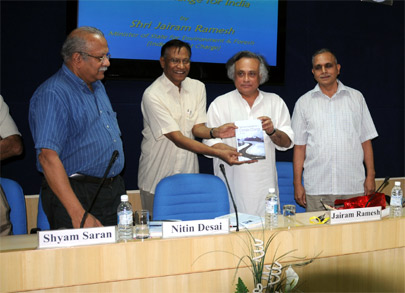You are here
Security Implications of Climate Change for India


About the Book
The IDSA Working Group on Security Implications of Climate Change for India felt that while it would be proper to oppose the securitisation of climate change, it would be prudent not to ignore its likely security dimensions. The Working Group Report identifies India's key vulnerabilities. Future projections of surface warming over India indicate that the annual mean area averaged surface warming is likely to be between 2 degrees and 3 degrees celcius and 3.5 and 5.5 degrees celcius by the middle and end of 21st century respectively. Trends in sea level rise indicate a possible rise between 1.06 to 2.75 mm per year. Every 1.0 degree rise in temperature would reduce wheat production by 4 to 5 million tonnes. Water scarcity will threaten food supplies in India. A quarter of our biodiversity could be lost.
The Working Group felt that climate change cannot be delinked from the overall energy security and economic growth. The National Action Plan on Climate Change is a good beginning but its time-bound implementation needs to be ensured. India needs to improve energy efficiency in the industrial, household and transport sectors. The Working Group also looked at the possible adverse impact on the strategy and tactics of Indian armed forces. India should use climate change as an opportunity to make socio-economic development more sustainable.
Content Page
About the Contributors
Foreword
Preface
Abbreviations
1. Climate Change and Security: Exploring the Link
— Arvind Gupta and Sujit Dutta
2. Key Vulnerabilities Due to Climate Change
— Murari Lal and Sunil Chauhan
3. Climate Change and Disasters
— Sunil Chauhan
4. Climate Change and Migration
— P.K. Gautam
5. Energy and Climate Change
— Shebonti Ray Dadwal
6. Economics and Adaptation to Climate Change
— Purnamita Dasgupta
7. Impact on India’s Bilateral Relations with Neighbouring Countries
— Uttam Kumar Sinha, Sreeradha Datta, Sunil Chauhan and P.K. Gautam
8. Impact on Warfighting Capability of the Indian Military
— Sunil Chauhan, P.K. Gautam and Ajey Lele
9. Climate Change: India’s Negotiating Position
— Arvind Gupta, Sujit Dutta and Uttam Kumar Sinha
10. Conclusion
— Arvind Gupta, Sunil Chauhan and P.K. Gautam
Appendices
Appendix A: Bali Action Plan
Appendix B: Indicative Timetable for Meetings of the Ad Hoc Working Group on Long-term Cooperative Action under the Convention in 2008
Appendix C: CO2 Excluding Lulucf (Land Use, Land Use Change and Forestry) in Gg CO2 Equivalent of some Annex 1 Countries in Giga Grams (1 Giga Gram=10 Billion Grams)
Glossary

